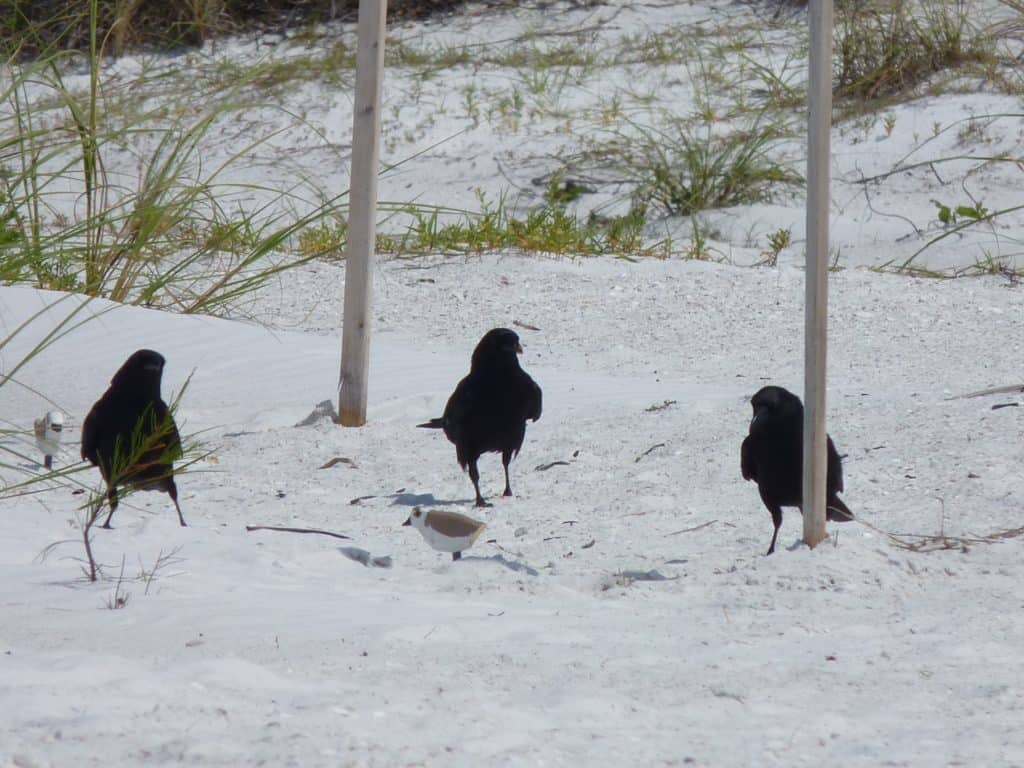Share this article
WSB: Electric shocks deter fish crows from seabird colonies
It may come as a shock, but electrifying fake seabird eggs and filling them with toxins are both strategies that help protect imperiled seabirds from crows.
Fish crows (Corvus ossifragus) often subsidize their diets with human food on popular beaches, which bolsters their populations in many parts of the Florida coast. But sometimes, these birds develop a taste for seabird eggs, like those from black skimmers (Rynchops niger) and least terns (Sternula antillarum), both species that are listed as threatened by the state of Florida. They can also prey on imperiled snowy plovers (Charadrius nivosus) nests.
“The problem is not just on our beaches, but statewide, and probably even goes broader,” said Elizabeth Forys, a professor of environmental studies and biology at Eckerd College in Florida.
Fish crows are fairly intelligent and organized when they attack seabird nests. Forys once saw a crow distract black skimmers, while others swooped in and stole their eggs.
“We even had one that was pulling seabirds off their nest to get at their eggs,” she said. In some cases, a murder of nine crows would distract or otherwise scare off individual skimmers from their nests, one by one. If enough fish crows are around, they can destroy the nests of a whole black skimmer colony.
Forys and her colleagues wanted to see if they could find a way to dissuade the corvids from approaching skimmer colonies in Pinellas County, east of Tampa.
They initially tried shooting some birds, but this was difficult to do given the popularity of the beaches for tourists — there were always people out there. Traps also didn’t work. And when the researchers tried hanging up dead crows to see if they would dissuade the living ones, they didn’t have much luck either.
Finally, they decided to try more complicated measures. In a study published recently in Wildlife Society Bulletin, they injected hollow quail’s eggs with carbachol — normally an eye medicine — and surrounded them with skimmer decoys to attract the fish crows. The treatment seemed to work during the first year of field work in the 2016 seabird breeding season — the crows vomited after ingesting the eggs, and were dissuaded from coming back to prey on eggs again.

A fish crow vomiting after ingesting a toxin planted by researchers as a deterrent. Credit: Elizabeth Forys.
The trouble was the birds sometimes cache eggs to eat later, burying them on the beach where humans might accidentally come into contact with the venom. “This is a toxic substance, and they’re burying the eggs on these busy beaches,” Forys said.
Given the potential danger these eggs could pose to humans, they decided to try another technique in the 2017 breeding season.

Some crows are inventive. This one tried to get an egg by landing on a decoy, but its plan didn’t work.
Credit: Elizabeth Forys
They placed electrified wire into eggs that sat in the middle of a buried metal plate. “When the fish crow stood on the plate, if its mouth opened up and had some moisture and grabbed the egg, it would have an electrified shock,” Forys said. “I’ve zapped myself several times — it’s not pleasant.”
They set up cameras to watch the action and saw that after receiving an initial shock, the electrified crow would make a strange noise to its companions and the whole murder would take flight for several hours.
“Even if the crows have already had a taste for the eggs, it still works,” Forys said, adding that she believes the shocks are enough to scare the crows off and send them back to stealing french fries from tourists.
Forys said that while both techniques work to train crows to avoid skimmer eggs, the second is probably safer, especially on popular beaches.
They also tried both techniques with snowy plover eggs, but didn’t see quite the same success. Forys said this is partly due to the fact that the plovers are solitary nesters, unlike the skimmers that nest in colonies. Nest predation on an individual plover nest didn’t necessarily stop after crows were shocked, Forys said, but it did slow down.

Fish crows were more hesitant to eat plover eggs after being shocked previously. They eventually left without trying to eat these fake eggs. Credit: Elizabeth Forys
Electrified eggs could also be used in other parts of the world, she said, as many imperiled seabirds are also threatened by corvids.
“I think it would work elsewhere and perhaps with other types of crows or ravens,” she said.
This article features research that was published in a TWS peer-reviewed journal. Individual online access to all TWS journal articles is a benefit of membership. Join TWS now to read the latest in wildlife research.
Header Image: A black skimmer colony in Florida with a fish crow in the background attempting to take an electrified egg. Credit: Elizabeth Forys








